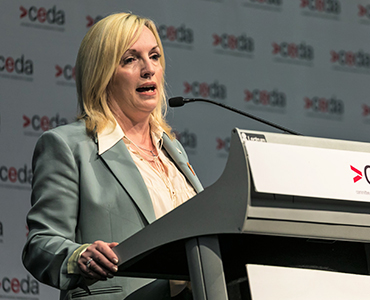
Despite 2018 bringing Australia Post $6.8 billion in revenues, $134 million in profits and the organisation delivering more than three billion items, there are significant problems and opportunities ahead.
“We are the only business in Australia that still touches every home and every business,” she said.
“Our letters business is $2.4 billion and its volumes has fallen by 30 per cent in the last three years alone, despite having to deliver to 500,000 more homes.
“Last year our letter business lost $45 million, so looking out with no big changes happening any time soon, I am looking down a tsunami of further losses.
“That creates an interesting dynamic, particularly when our letters have been our most profitable business and to replace every $1 of letter revenue I have to get $2 out of parcels.”
Ms Holgate said that on top of a rapidly changing business model, Australia Post must also juggle a community service obligation with profitability while managing more than 1,000,000 complaints in 2018.
“For every person that I employ in rural and regional Australia there are two more jobs created in the economy,” she said.
“700,000 complaints were saying ‘where is my parcel and when will it arrive?’
“Analysing these complaints, it became evident people wanted to know we’re tracking and they wanted automation.
“When I mentioned this to the workforce all they could think about was ‘you’re going to take my job away.’
“If we have a job and it creates two, you take one away and you lose two.
“It would have a massive impact in rural and regional Australia and we are the largest employer outside of metro cities.”
Ms Holgate also said that with 35 per cent of the Australia Post workforce set to retire within the next five years she is set to lose the organisations most skilled and experienced workers – they are typically also male.
This is on the back of workforce participation by men in Australia dropping from 80 per cent to 70 per cent and female workforce participation increasing from 40 to 60 per cent in the last 40 years.
“To drive a motorbike and to lug massive boxes generally appeals to men not women and 80 per cent of our workforce in our operational teams are men, so when I have so many men falling out of the workforce, I’m thinking where am I going to get my workforce from?” she said.
“If we want to secure a workforce so we can deliver to the people of Australia, then actually we’ve got to retain and love our men, we’ve got to encourage women in our workforce and we’ve got to be far more flexible and start thinking about part-time workers and people working in different types of shifts.”
Ms Holgate said she takes the element of community service and moral responsibility obligations seriously when considering future investment plans by the organisation.
With 80 per cent of Australia Post’s costs fixed to labour, matched with the need to invest in post offices, training and up skilling staff, Ms Holgate says she is a “glass half full kind of girl”.
“Many other organisations in the world are facing the challenges Australia are, what can we learn from our brothers and sisters elsewhere?” she said.
“I have persuaded our board to embark on a journey of growth because if we are to reimagine our workforce, protect our workforce, to grow jobs, there’s only one way to do it and that’s to grow our business.
“Despite the juggernaut of letter decline happening I’ve got an element of confidence that we can do it, so we’ve invested that $300 million into our network and I’m pleased to say that if we hadn’t have invested that money we couldn’t have delivered Black Friday and Cyber Monday.
“As we put automation into our business it hasn’t cut our jobs, it’s enabled us to attract women into our workforce because automation is allowing women to come into what was previously very manual jobs.
“It’s also helping us protect our older males because previously they felt they had to retire in their early 60s because the work was so manual, now they can go on to our mail processing lines and continue to have a career with us.
“So, we want to embrace technology, we don’t want to be afraid of it.”
Event presentations
Christine Holgate, Australia Post MP3
Panel discussion MP3